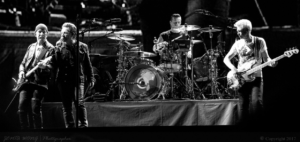The Sacred and Profane: Unveiling Cultural Symbols’ Dualistic Essence

Updated On: April 20, 2024 by Maha Yassin
In our quest to comprehend human culture’s and symbolism’s depths, we encounter a distinct bifurcation: the sacred and the profane. These two facets of cultural symbols permeate societies, shaping religious beliefs and rituals and extending their influence to arts, literature, and social structures. The sacred can be understood as transcending ordinary life, manifesting as divine or sublime, often revered and surrounded by ritualistic practices. Conversely, the profane encompasses the secular, the everyday aspects that are not imbued with religious significance. Together, these elements define the dual nature of cultural symbols and illustrate the multifaceted experience of human existence.
Our exploration delves into the history and evolution of sacred symbols, acknowledging their pivotal role in shaping communal identities and personal beliefs. Sacred spaces and practices frame temporal experiences, while literature and the arts recount tales of the sacred, prompting us to reflect on the ethical dimensions of the profane. Additionally, contemporary perspectives challenge us to consider how these age-old constructs operate within modern societies and how they are redefined in a continuously evolving cultural landscape.
Defining the Sacred and Profane
When exploring cultural symbols, it’s imperative to understand the dichotomy of the sacred and profane. The sacred encompasses that which is considered holy, divine, or transcendent. These elements of our world surpass everyday existence and are often associated with religion and myths. Sacred entities are inviolable, set apart from the ordinary, and demand respect or reverence.
On the contrary, the profane refers to the secular, everyday life. This is anything considered not sacred, including ordinary, mundane, or commonplace aspects of life. The profane allows for individual interests and the satisfaction of personal needs without the constraints that the sacred might impose.
| Sacred | Profane |
|---|---|
| Holy | Secular |
| Divine or transcendent | Mundane or ordinary |
| Associated with ritual | Related to personal needs |
| Venerable | Commonplace |
Renowned scholar Mircea Eliade discussed these concepts in depth, positing that understanding the sacred and profane is fundamental to grasping the human experience. He suggested that the sacred is essential for finding the deeper meaning in life, while the profane represents the routine of the natural world.
The interplay between these two realms gives us insight into various societies’ values, beliefs, and structures. Acknowledging the duality helps us discern the nature of things and the division of the world in cultural and philosophical terms. It’s a framework that defines the spectrum of meaning from the absolute to the relative, the divine to the everyday.
Historical Perspectives on Sacred Symbols
Sacred symbols have played a pivotal role throughout human history, embodying various cultures’ core beliefs and values. Our in-depth exploration reveals these symbols’ depth and significance within different societies.
Symbolism in Ancient Civilisations
Exploring ancient civilisations, we uncover a tapestry of cultural richness where symbols form a fundamental part of religious life. The cross, for instance, long before its adoption by Christianity, was utilised in numerous pagan traditions, signifying aspects of life, the cosmos, and spirituality.
Egyptian civilisation offers us a splendid array of sacred symbols. The Ankh, resembling a cross with a loop at the top, represents life and the omnipresence of the divine. Likewise, Hinduism is rife with deeply significant symbols; the Om sign is both a visual and auditory symbol encapsulating the essence of the universe.
Turning our look to Islam, we find the crescent moon and star, prominent on many flags and in Islamic art, symbolising sovereignty and guidance. However, it is not necessarily theologically grounded in Islamic texts. The Star of David, known in Hebrew as the Shield of David (Magen David), carries the weight of Jewish identity and history. However, its origins as a Jewish symbol are relatively late, becoming widespread only in the Middle Ages.
Furthermore, our investigation highlights that each symbol, be it the Dharmachakra of Buddhism or the intricate Mandala, is often shared across different faiths and periods, transcending its initial religious context to become a part of the broader human heritage. Through this historical lens, we grasp the enduring potency and the shared humanity encapsulated by these sacred symbols.
Roles of Rituals and Traditions
Rituals and traditions embody the essence of cultural identity and continuity, serving as the heartbeat of societal cohesion and spiritual expression.
Transition and Continuity
Rituals often mark significant passage of time, transitions, and societal changes. Traditions such as annual festivals and religious ceremonies offer stability and continuity amidst our rapidly changing world. They help maintain the fabric of our cultural heritage and ensure the transmission of our collective values and beliefs across generations.
Sacred Rituals in Society
In every culture, sacred rituals stand apart from mundane activities. They create a structured space in time where participants can engage with the spiritual realm. Religious practices, like rites of passage, allow individuals to step into different stages of life with communal support and recognition. These ceremonies often re-enact ancient myths, connecting us with a timeless dimension and bringing a deeper sense of purpose to our lives.
Sacred Spaces and Places

In exploring cultural symbols, it’s crucial to understand the distinction and significance of sacred spaces and places as they offer profound insight into societal values and beliefs.
Religious Architecture
The creation of religious architecture represents a tangible expression of the sacred. Buildings such as Catholic churches embody an architectural embodiment of the divine, often designed to mirror heaven on earth or the axis mundi. This central point is symbolic and serves as a place where heaven and earth are believed to connect. The layouts of these religious structures frequently convey cosmological significance, with orientation, spatial arrangement, and embellishments all enhancing the sacredness of the place.
Natural Sacred Sites
Natural sites often hold as much sacred value as man-made structures. Natural sacred sites like mountains, rivers, and forests can function as spaces where the divine is felt more palpably. These places are not just locations but are spiritually enriched by narratives and rituals, forming an imago mundi that reflects the universe’s harmony within nature. The sanctity of such sites can inspire awe and reverence, grounding religious and spiritual experiences in the physical realm.
Through understanding both the religious architecture and natural sacred sites, we gain a clearer insight into the cultures and belief systems that define and are, in turn, defined by these significant locations.
Temporal and Seasonal Sacraments

In the tapestry of human experience, certain temporal and seasonal sacraments stand out, deeply embedded in the life cycle from birth to death. These time-honoured rituals and traditions reflect the sacred dimensions of our existence, punctuating our journey with moments of reflection and reverence.
Cyclical Time in Religious Practice
In many cultures, the concept of time is not linear but cyclical, marked by recurring seasonal festivals and rites that bring communities together. These are often linked to agricultural cycles, symbolising renewal and continuity. For example, the spring equinox is celebrated in various religions as a time of rebirth; it parallels the Christian celebration of Easter or the pagan festival of Ostara, each marking a transition from death or dormancy to life.
Religious rituals tied to specific times emphasise the connection between the divine and the mundane. The Jewish tradition observes Shabbat weekly, commencing at sunset on Friday, symbolising a sacred pause in the work cycle—a time when the divine rests, as do we.
Our birth and death are also enshrined in ritual—baptisms, naming ceremonies, and funerals serve to recognise and sanctify these critical junctures in our lives. These ceremonies echo the seasonal rhythms, representing personal springtimes and winters, binding our narratives to the greater story of humanity.
The Sacred in Literature and Arts

In our exploration of cultural symbols, we uncover the profundity of the sacred as it is interwoven into the fabric of literature and the arts. The following subsections discuss this alignment specifically through metaphors and mythology, as well as the visual language of iconography.
Metaphors and Mythology
Mythology serves as a repository of the sacred, a realm where literary symbols are drenched in spiritual significance. For instance, the cross in Christian literature is not merely an intersection of two lines; it symbolises suffering, hope, and enlightenment. Similarly, the enduring symbols like mezuzahs on doorposts in Jewish tradition or the stations of the cross in Christian art, are encoded with layers of meaning that transcend their immediate context. They act as metaphors that bridge the divine and the mundane, enabling literature to extend beyond the profane into the realm of the sacred.
Iconography and Aesthetics
Moving into the aesthetic domain, the sacred captures our senses through iconography, shaping our art experience. In the gentle brush strokes of Renaissance paintings, every detail may unveil a spiritual dimension. Symbols such as haloes and divine light in religious art can evoke a sense of reverence and wonder. This visual language invites us to recognise the sacred embedded within the canvas of history, beckoning a contemplative engagement with what is portrayed. Through symbolic art, we encounter a profound reflection on the sacred, which invites a pause, a moment of connection to something greater than ourselves.
Social and Cultural Dynamics
In our societies, sacred symbols and cultural expressions foster unity and a sense of belonging. These dynamics are key to understanding how human culture evolves and is experienced.
Sacred Symbols in Social Cohesion
Sacred symbols often serve as a central axis for fortifying social cohesion. Through these shared symbols, societies find common ground, allowing individuals to feel part of a larger community. For instance, rituals and festivals often revolve around special symbols or activities that crystallise our collective identity, reinforcing the values and norms that bind us.
Symbols and Identity
Symbols are also intrinsic to the fabric of our individual and collective identities. They can be as diverse as the flags we fly or the religious icons we place in our homes. In their presence, we find elements of culture, history, and personal experience, creating a mosaic that is representative of our varied identities. Symbols not only tell a story about who we are but also about our aspirations and how we relate to the wider society.
Ethics, Morality, and the Profane
In our exploration of cultural symbols, it’s crucial to understand that the profane aspects of culture are often where society delineates its ethical and moral boundaries.
Taboos and Ethical Boundaries
Taboos are typically deeply ingrained in societal norms, shaping behaviours and influencing personal and collective moral compasses. These are not merely guidelines; they represent the underlying ethical framework that dictates what is deemed acceptable or offensive within a community. Violating these taboos can provoke disrespect, fear, or even social ostracisation, highlighting their critical role in maintaining societal order.
Interestingly, what one culture may regard as profane, another might see as a neutral or sacred act. This can create a complex mosaic of intercultural ethics that reflects a multitude of worldviews. Navigating these differences requires a blend of hope and understanding in the face of complexity. Our collective morality, while diverse, often seeks to promote respect for different beliefs and practices, even when they fall outside our understanding of the sacred.
When discussing the profane in the context of ethics and morality, one must tread carefully, acknowledging that what may seem mundane or unsanctified might just as readily embody a set of moral principles for another. Our interpretation of the profane is deeply tied to our own ethical and moral judgements.
Intersections of the Sacred and Secular

Our cultural landscape is marked by entities that often seem at odds: the sacred and the secular. These domains intersect in myriad ways, particularly in public spaces where symbols and practices can take on a dual nature, reflecting both divine and mundane significances.
Public Spaces and Symbols
Public spaces serve as critical arenas where the sacred and secular converge. The U.S. flag, for example, is a powerful emblem found in various secular settings, from government buildings to schools. Yet, it often takes on a sacred dimension during ceremonies and rituals, where it’s revered almost as a sacred or divine entity in itself.
In this realm, the secular context of public space does not preclude the presence of the sacred; rather, it often amplifies it by providing a platform where the significance of these symbols broadens to encompass collective identities and values. Our public arenas become stages where the temporality of the mundane meets the timelessness of the divine, each lending meaning to the other.
Contemporary Issues and Perspectives
In this section, we examine how religion interacts with and adapts to the fast-paced changes of modern society.
Religion in the Modern World
Religion continues to play a significant role in our lives despite the increasing secularisation of society. We find that religious experience now competes with a myriad of secular activities, presenting both challenges and opportunities. In modern society, the lines between the sacred and the profane become blurred, as elements of secular life take on sacred qualities for some individuals. For instance, Durkheim’s idea of Sacred and Profane explains how collective rituals, even in secular contexts, can create a sense of community and shared purpose.
Challenges and Adaptations
Religions face the challenge of maintaining relevance within an ever-diversifying global landscape. This diversity necessitates religious institutions to reconsider their structure and the freedom they offer to individuals seeking spirituality outside traditional frameworks. A critical approach to hermeneutics after Kant, as noted in The Sacred and the Profane, is vital to navigate this changing environment. In our critique, we must acknowledge how faith systems are transforming with an emphasis on inclusive love over exclusive dogma, allowing them to resonate with broader audiences.

FAQs
Our exploration of cultural symbols delves into the complex tapestry of beliefs and social practices that differentiate the sacred from the profane. The questions below guide us through the key aspects of this dichotomy, revealing how pervasive these concepts are in our society.
What constitutes the distinction between sacred and profane entities in religious practice?
In religious practice, sacred entities are revered and considered worthy of spiritual respect or devotion. This contrasts with profane entities pertaining to ordinary, everyday things not imbued with religious significance. The sacred/profane dichotomy is central to understanding the religious classification of actions and spaces.
How does Durkheim’s concept of the sacred and profane apply to sociology?
Durkheim’s concept posits that the sacred and profane are essential classifications underpinning society’s collective conscience. In sociology, this distinction helps explain the social cohesion and the formation of collective beliefs, moral boundaries, and social norms within a community.
Could you elucidate the theory of the sacred and the profane?
As detailed by Mircea Eliade, the theory of the sacred and the profane explains that the sacred is the realm of the extraordinary, transcendent, and holy. In contrast, the profane pertains to the commonplace and ordinary realm of existence. His work investigates the human tendency to seek the sacred and separate it from the profane.
What are some quintessential examples that illustrate sacred and profane elements in society?
Examples of sacred elements include religious artefacts, places of worship, and rituals. Profane elements encompass everyday objects, secular spaces, and non-religious activities. The dual nature reflects society’s division between that which is consecrated and that which is secular.
In what ways does the dual nature of cultural symbols manifest in the sacred and profane?
Cultural symbols often bear a dual nature, being revered in certain contexts while maintaining a commonplace status in others. For instance, water might be considered sacred when used in baptism, whereas it is profane for cleaning. This duality highlights the context-dependent interpretation of symbols.
How are the sacred and profane concepts explored throughout various religious frameworks?
Across religions, the concepts of the sacred and profane are explored through texts, rituals, moral codes, and myths. Each framework sets unique parameters for what is considered holy or unholy, often dictating the physical and metaphysical spaces where the sacred can be encountered.






